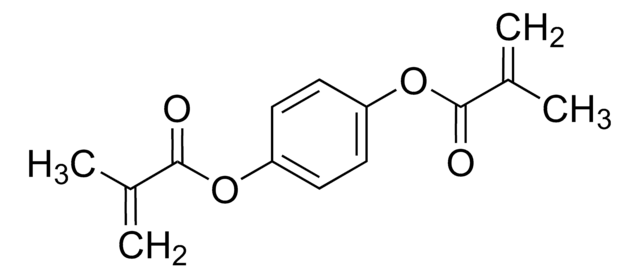494356
Bisphenol A glycerolate dimethacrylate
glycerol/phenol 1
Sinonimo/i:
2,2′-Bis[4-(3-methacryloxy-2-hydroxypropoxy)phenyl]propane, 2,2′-Bis[4-(3-methacryloyloxy-2-hydroxypropoxy)phenyl]propane, 2,2-Bis[p -(3-methacryloxy-2-hydroxypropoxy)phenyl]propane, 2,2-Bis[p -[2-hydroxy-3-(methacryloxy)propoxy]phenyl]propane, Bisphenol A bis(2-hydroxy-3-methacryloxypropyl) ether
About This Item
Prodotti consigliati
Composizione
glycerol/phenol, 1
Indice di rifrazione
n20/D 1.552 (lit.)
Densità
1.161 g/mL at 25 °C (lit.)
Temperatura di conservazione
2-8°C
Stringa SMILE
CC(=C)C(=O)OCC(O)COc1ccc(cc1)C(C)(C)c2ccc(OCC(O)COC(=O)C(C)=C)cc2
InChI
1S/C29H36O8/c1-19(2)27(32)36-17-23(30)15-34-25-11-7-21(8-12-25)29(5,6)22-9-13-26(14-10-22)35-16-24(31)18-37-28(33)20(3)4/h7-14,23-24,30-31H,1,3,15-18H2,2,4-6H3
AMFGWXWBFGVCKG-UHFFFAOYSA-N
Categorie correlate
Descrizione generale
- Phenyl ring provides chemical resistance
- Ether linkage allows flexibility
- Hydroxyl group gives good adhesion
- Methacrylate is the reactive site for crosslinking
Applicazioni
- As a crosslinking monomer in the preparation of zwitter ionic monolithic columns for liquid chromatography.
- In the preparation of an antibacterial dental adhesive.
Avvertenze
Danger
Indicazioni di pericolo
Consigli di prudenza
Classi di pericolo
Aquatic Chronic 3 - Eye Dam. 1 - Skin Sens. 1
Codice della classe di stoccaggio
10 - Combustible liquids
Classe di pericolosità dell'acqua (WGK)
WGK 2
Punto d’infiammabilità (°F)
230.0 °F
Punto d’infiammabilità (°C)
110 °C
Certificati d'analisi (COA)
Cerca il Certificati d'analisi (COA) digitando il numero di lotto/batch corrispondente. I numeri di lotto o di batch sono stampati sull'etichetta dei prodotti dopo la parola ‘Lotto’ o ‘Batch’.
Possiedi già questo prodotto?
I documenti relativi ai prodotti acquistati recentemente sono disponibili nell’Archivio dei documenti.
I clienti hanno visto anche
Articoli
With dentists placing nearly 100 million dental fillings into patients′ teeth annually in the U.S. alone, polymeric composite restoratives account for a very large share of the biomaterials market.
Il team dei nostri ricercatori vanta grande esperienza in tutte le aree della ricerca quali Life Science, scienza dei materiali, sintesi chimica, cromatografia, discipline analitiche, ecc..
Contatta l'Assistenza Tecnica.















